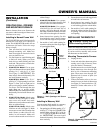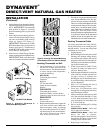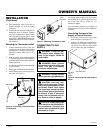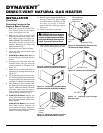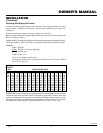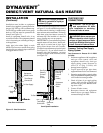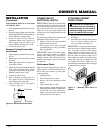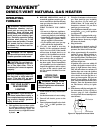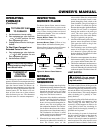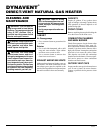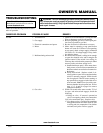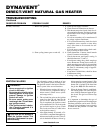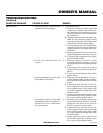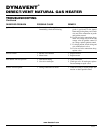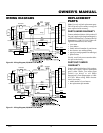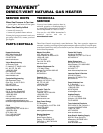
13
201835
OWNER’S MANUAL
OPERATING
FURNACE
(Continued)
1. Set thermostat to lowest setting
2. Turn equipment gas valve clockwise
to OFF position. Do not
force equipment gas valve.
3. Unplug furnace if service is to be per-
formed.
To Shut Down Furnace for an
Extended Period of Time
1. Turn equipment gas valve clockwise
to OFF position. Do not
force equipment gas valve.
2. Set thermostat on OFF.
TO TURN OFF GAS
TO FURNACE
CAUTION: Do not try to adjust
heating levels by using the equip-
ment shutoff valve.
The thermostat responds to the room tem-
perature. When the room temperature drops
below the thermostat setting, the thermostat
turns the furnace burner and blower on.
When the room temperature goes above the
thermostat setting, the thermostat turns the
furnace burner off. The blower will con-
tinue to blow about two to three minutes
after the burner goes out. The thermostat
keeps the room at a constant temperature.
THERMOSTAT
CONTROL
OPERATION
INSPECTING
BURNER FLAME
To observe burner flame, remove furnace
front cover. Remove the two screws at the
lower edges of front cover. Lift front cover
away. Locate viewing window on front of
combustion chamber. You can see burner
flame through this window.
Correct Burner Flame: Blue flame with
well-defined burner ports.
Incorrect Burner Flame: Yellow or lazy
flame without well-defined burner ports.
If burner flame is incorrect, shut off furnace
and contact a qualified service person.
Correct Flame
Pattern
Incorrect Flame
Pattern
Figure 19 - Burner Flame Patterns
NORMAL
OPERATING
SEQUENCE
1. When the room temperature drops below
the thermostat setting, the thermostat calls
for heat. A 24-volt circuit is completed
through the time delay relay coil. After
three to five seconds, the contacts in the
relay close. The blowers come on.
2. One motor drives both the combustion
air blower and the circulating room air
blower. The combustion air blower
draws air from outside through the in-
take air vent. This air discharges into
the combustion chamber. The combus-
tion air blower then forces the combus-
tion products out of the exhaust tube(s).
The Combustion air blower is sealed
so that air does not pass between it and
the circulating room air blower.
3. When the blower motor reaches 75% of
normal r.p.m. (three to five seconds), air
from the blower turns on the
microswitch. When the microswitch
activates, the electrical circuit is com-
pleted through the limit switch to the
control module. The glo bar begins to
glow. In about 15 seconds, the glo bar
becomes hot enough to ignite the burner.
4. Another 24-volt circuit is completed
through the module to the main gas
valve. The valve opens. Gas passes
through the valve to the main burner.
The gas is ignited by the glo bar.
5. After the main burner ignites, the flame
detector senses the presence of flame.
This opens the circuit to the glo bar.
The glo bar shuts down.
6. The circulating room air blower pulls
return air in from the living area. This
air is heated as it flows past the com-
bustion chamber. The heated air is then
blown out into the room.
7. When the room temperature rises above
the thermostat setting, the circuit to the
valve opens and the burner shuts off.
8. The blower continues to run about two to
three minutes until the time delay relay
coil cools. When the coil cools, the circuit
to the motor opens. The blower shuts off.
LIMIT SWITCH
WARNING: Do not operate
furnace without a properly-work-
ing limit switch.
The limit switch will turn off the gas to the
main burner if the furnace becomes too hot.
When this happens, the main burner will go
out and the blower will continue to run for
two to three minutes. This usually happens
when circulating air is partially or com-
pletely blocked.
Occasional cycling of the limit switch is not
bad. This indicates safe operation. Limit
switch cycling will most likely occur on
warm days. If this happens too often or for
a long period of time, the circulating air
system should be thoroughly cleaned by a
qualified service person.
If the circulating air system is cleaned and
the limit switch continues to shut down the
furnace, the limit switch is defective. A
defective limit switch cannot be repaired. It
must be replaced. For safety reasons, never
operate the furnace without a limit switch.



